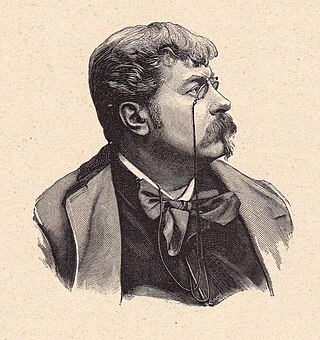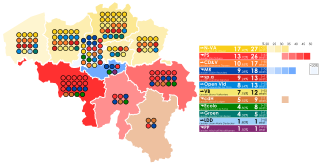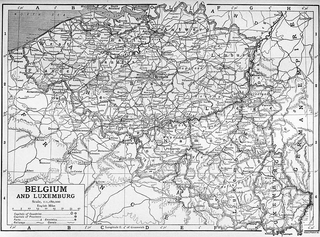
Antoine Louis Camille Lemonnier was a Belgian writer, poet and journalist. He was a member of the Symbolist La Jeune Belgique group, but his best known works are realist. His first work was Salon de Bruxelles (1863), a collection of art criticism. His best known novel is Un Mâle (1881).

Jean-Baptiste Descamps was a French writer on art and artists, and painter of village scenes. He later founded an academy of art and his son later became a museum curator.

Charles Edmond Henri de Coussemaker was a French musicologist and ethnologist focusing mainly on the cultural heritage of French Flanders. With Michiel de Swaen and Maria Petyt, he was one of the most eminent defenders of the Dutch language in France.
The Walloon Movement is an umbrella term for all Belgium political movements that either assert the existence of a Walloon identity and of Wallonia and/or defend French culture and language within Belgium, either within the framework of the 1830 Deal or either defending the linguistic rights of French-speakers. The movement began as a defence of the primacy of French but later gained political and socio-economic objectives. In French, the terms wallingantisme and wallingants are also used to describe, sometimes pejoratively, the movement and its activists. To a lesser extent, the Walloon Movement is also associated with the representation of the small German-speaking population in the East Belgium of the Walloon Region.
The Walloon Movement traces its ancestry to 1856 when literary and folkloric movements based around the Society of Walloon language and literature began forming. Despite the formation of the Society of Walloon Literature, it was not until around 1880 that a "Walloon and French-speaking defense movement" appeared, following the linguistic laws of the 1870s. The movement asserted the existence of Wallonia and a Walloon identity while maintaining the defense of the French language.
The partition of Belgium is a hypothetical situation, which has been discussed by both Belgian and international media, envisioning a split of Belgium along linguistic divisions, with the Flemish Community (Flanders) and the French-speaking Community (Wallonia) becoming independent states. Alternatively, it is hypothesized that Flanders could join the Netherlands and Wallonia could join France or Luxembourg.
The history of Wallonia, from prehistoric times to the present day, is that of a territory which, since 1970, has approximately coincided with the territory of Wallonia, a federated component of Belgium, which also includes the smaller German-speaking Community of Belgium. Wallonia is the name colloquially given to the Walloon Region. The French word Wallonie comes from the term Wallon, itself coming from Walh. Walh is a very old Germanic word used to refer to a speaker of Celtic or Latin.

Federal elections were held in Belgium on 13 June 2010, during the midst of the 2007-11 Belgian political crisis. After the fall of the previous Leterme II Government over the withdrawal of Open Flemish Liberals and Democrats from the government the King dissolved the legislature and called new elections. The New Flemish Alliance, led by Bart De Wever, emerged as the plurality party with 27 seats, just one more than the francophone Socialist Party, led by Elio Di Rupo, which was the largest party in the Wallonia region and Brussels. It took a world record 541 days until a government was formed, resulting in a government led by Di Rupo.

Pieter van Mol or Peter van Mol was a Flemish painter known for his history paintings of religious subject matter, and to a lesser extent for his allegorical compositions, genre scenes and portraits. His style was profoundly influenced by Rubens, Abraham Janssens and Artus Wolffort. He was court painter to the King and Queen of France.

Belgitude is a term used loosely to express the typical Belgian soul and identity, often with a so-called keen sense of self-mockery that characterises its population. Originating from a perceived lack of common identity among the different communities, regions and language areas of Belgium, the neologism was coined in the 1970s and 1980s by allusion to the concept of négritude about feeling black, expressed among others by Léopold Sédar Senghor. It has since gained in popularity and has primarily been used to describe typical or unique aspects of Belgian culture.

The Lives of Flemish, German, and Dutch painters refers to a compilation of artist biographies by Jean-Baptiste Descamps published in the mid 18th-century that were accompanied by illustrations by Charles Eisen. The list of illustrations follows and is in page order by volume. Most of the biographies were translated into French from earlier work by Karel van Mander and Arnold Houbraken. The illustrated portraits were mostly based on engravings by Jan Meyssens for Het Gulden Cabinet and by Arnold and Jacobus Houbraken for their Schouburgh, while the work examples engraved in the margins of the portraits were mostly based on engravings by Jacob Campo Weyerman.

Joseph Octave Delepierre was a Belgian lawyer, archivist, diplomat, author and antiquary. He spent his later life in the United Kingdom, and is best known for his studies of macaronic language and literature.

Amédée Ernest Lynen (1852–1938), who often signed his works Am. Lynen, was a Belgian painter, illustrator and writer. In 1880, he was one of the founders of the artistic group L'Essor after it had separated from the academy, and he co-founded its successor Pour l'Art in 1892. In 1895, he founded the "Compagnie du Diable-au-corps", an artistic association which organised evenings with theatre and poetry, and which existed at least until 1899. It also published a satirical newspaper, Le Diable au Corps. In 1903, two works on paper were bought by the Royal Museums of Fine Arts of Belgium. In 1930, a retrospective of his works was organised by the Cercle Artistique et Littéraire in the Vauxhall, Brussels.
The Dutch language used in Belgium can also be referred to as Flemish Dutch or Belgian Dutch. Dutch is the mother tongue of about 60% of the population in Belgium, spoken by approximately 6.5 million out of a population of 11 million people. It is the only official language in Flanders, that is to say the provinces of Antwerp, Flemish Brabant, Limburg, and East Flanders and West Flanders. Alongside French, it is also an official language of Brussels. However, in the Brussels Capital Region and in the adjacent Flemish-Brabant municipalities, Dutch has been largely displaced by French as an everyday language.
Events in the year 1865 in Belgium.

The following events took place during 1911 in Belgium.

Belgian heraldry is the form of coats of arms and other heraldic bearings and insignia used in the Kingdom of Belgium and the Belgian colonial empire but also in the historical territories that make up modern-day Belgium. Today, coats of arms in Belgium are regulated and granted by different bodies depending on the nature, status, and location of the armiger.
Josse-Émile van Dievoet was a Flemish politician and lawyer. He served as Belgian Minister of Justice.
Anarchism spread into Belgium as Communards took refuge in Brussels with the fall of the Paris Commune. Most Belgian members in the First International joined the anarchist Jura Federation after the socialist schism. Belgian anarchists also organized the 1886 Walloon uprising, the Libertarian Communist Group, and several Bruxellois newspapers at the turn of the century. Apart from new publications, the movement dissipated through the internecine antimilitarism in the interwar period. Several groups emerged mid-century for social justice and anti-fascism.
Éliane Gubin is a Belgian historian, researcher and professor of political and social history, specializing in the history of women and feminism. In the late 1980s, she initiated the introduction of women's history at the Université libre de Bruxelles (ULB), where she is professor emerita. She also teaches the history of contemporary Belgium and specializes in social history and political history of the nineteenth century and the first half of the twentieth century, including a re-reading of the World War I. Since 1995, she has been co-director of the Centre d'archives pour l'histoire des femmes.











